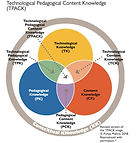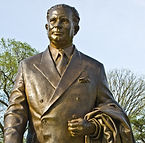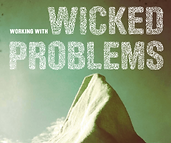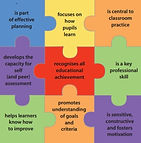Synthesis Essay

Photo Credit; Alamy.com
“No old road leads to new destinations! Change begins when one realizes that it is unwise to pour a new wine into an old wine skin. If you change your mind, you have to change your actions too!”
- Israelmore Ayivor, African Author -
New Wine Skins...
Embracing Growth
My students today carry a new mindset. My classroom instruction must now tie into the abundant and relevant learning that my students are embracing outside of the traditional brick-and-mortar school setting. My graduate studies in the Master of Arts in Educational Technology (MAET) have pressed me towards a growth mindset and pushed me to embrace uncertainty, allowing me to risk being wrong, and to engage with error. I have leaned to develop ideas, to correct errors, and to be “on fire with yet” (Carol Dweck, 2014).
Within the ten foundational classes in the MAET sequence, several crosscutting themes emerged that defined my learning experience. These themes include; Leadership and Research, Wicked Problems in Education, Creativity, Technology Pedagogy and Content (TPACK), Online Teaching, and Electronic Assessment.
My personal experiences in collaborative learning helped me to successfully communicate as a novice technology mentor. I now feel prepared to reach out to my peers at school to share what I have been learning.
For Approaches to Educational Research (CEP 822), I chose to write a literature review that evaluated the preparation of future Physics Teachers, and the web of contemporary interactions existing between professional organizations, universities and colleges, as well as secondary public and private schools. As my personal training was very nontraditional, I have been interested in alternative pedagogical models for physics instruction in collegiate and secondary schools.
I learned that to sustain meaningful reform, physics preparation programs must take full advantage of this ongoing research and embrace approaches and clinical experiences that model effective learning environments. These experiences must allow the integration of content knowledge in physics as well as physics-related pedagogy and evolving technologies.
,
For my literature review, I researched examples of Professional Learning Communities (PLC)s that were established to discourage professional isolation, support reforms, and simultaneously encourage collaboration among physics teachers. These PLCs are supporting certification programs while maintain a commitment to teacher preparation reform in physics-specific pedagogy. My research has motivated me to form a coalition of local interested secondary teachers to meet with the Physics and Physics Education departments of universities in my region. I believe that a vision for a connected Physics community will be needed to sustain physics teacher preparation reform.
I researched the "achievement gap" in my Applying Educational Technology to Issues of Practice (CEP 812) class. My professional practice was deeply changed by this experience. I began to understand how many of my students had experienced significant trauma in their personal lives, and that interventions were needed to address the achievement gap for these students. My team defined the achievement gap as the difference in academic performance between various groups of students (i.e. race, socioeconomic status, geographic location, etc). I studied dropout rates, graduation rates, enrollment and admittance to college and professional programs in relationship to the achievement gap. My group developed a plan for actionable potentials that leaders could take to close the achievement gap. Options included inviting community leaders to serve as mentors, developing after school programs with local a community sponsors, trauma training, and additional psychological support for students. Since my long term goals include developing an online school for refugees, I found this research of achievement gap to be both compelling and motivating.
I found that a blended classroom afforded diverse options for student learning. I was intrigued by the usage of the terminology "disruptive innovation" in education. With the current district-wide emphasis resting on Universal Design for Instruction (UDI) and increasing student use of available support technologies, disruption appears to be inevitable. Since my school district has prioritized a goal to infuse a Universal Design for Instruction (UDI) into planning. I found that a blended classroom afforded diverse options for student learning. I have been intrigued by the usage of the terminology “disruptive innovation” in education.
As I am beginning to utilize technology to support blended learning, I am finding more classroom time to engage students in individualized learning. Classroom time is now utilized to the greatest extent possible to meet the diverse learning needs of the students. Designing a blended or flipped classroom assessment strategy has taken time. My earlier practice of providing in class group lectures was revised when home study via student Chromebooks became an option. Designing and creating online assessment tools supported the district UDI goals for targeted instruction. The use of Chromebooks fueled opportunity for individualized feedback to remediate or enrich the student learning experience. By developing my first blended learning class, I took advantage of enhanced interactive communication afforded by the use of student Chromebooks.
I increased the frequency of individualized feedback with my students. Supported by the blended classroom design, I found I could increase assessment options by offering greater flexibility for student choice. My first opus of a blended class may lead to the creation of a completely flipped classroom or eventually to the design of completely online class for a different venue. During my years as a professional, I have seen a large change in the definition of homework. I have considered arguments that promote no homework at all. A flipped classroom is not advocating homework, rather the out-of-classroom experience augments what a student can learn. As I am now using my first blended classroom model, find that the students are enjoying the flexibility and that the format affords better use of in class time for activities that can be supported by the presence of an experienced guide.
European Union, (2019), Free Digital Learning Opportunities for Migrants and Refugees, An analysis of Current Initiatives and Recommendations for Their Further Use, Retrieved from
https://core.ac.uk/download/pdf/141667106.pdf
University Archives & Historical Collections, (n.d), John A. Hannah, Retrieved from http://www.archives.msu.edu/collections/presidents_hannah_j.php





Leadership
Wicked Problems

Creativity
TPACK
Online Learning
Assessment
Leadership and Wicked Problems
I learned in Technology and Leadership, (CEP 815) that risk and potential failure on the road to success define the dynamic environment of technology leadership. As a classroom leader today, I will need to demonstrate how technology can be used to inform and support the culture of change. Also in CEP 815 I practiced mentoring skills, capitalizing on my strength to be a supportive and also evaluative listener. I also needed to organize and synthesize my thoughts, using my own experience as a launching pad. My knowledge about educational technology and specifically a TPACK perspective were essential tools that I used to inform my support for the first year MAET teacher.
Creativity
Creativity in Teaching and Learning (CEP 813) was by far my most enjoyable class in the MAET sequence. The book that we used as a text, "Sparks of Genius. The 13 Thinking Tools of the World's Most Creative People" by Robert and Michelle Root-Bernstein inspired me to create a website to be used as a teacher resource to reach across traditional curricular barriers combining poetry and physics in cross-curricular instruction. I found that throughout the MAET courses creativity resonated with, inspired, and expanded my vision for the use of technology in the classroom.
I was continually drawn back to the major themes of the class: synthesizing, play and transfer, abstracting, patterning and analogizing, embodied thinking and empathizing.
Employing technology tools creatively has inspired me to encourage students to broaden their horizons as the shape of the learning environment is transformed. Students in my science classes experience established patterns. These patterns are new to them. Yet, these young minds must be inspired to fill old wineskins with new wine, adding their own creativity and understanding to the science anthology, while participating in scientific discovery with a sense of awe and wonder.
Technology Pedagogy and Content (TPACK)
Teaching for Understanding with Technology (CEP 817) also provided an overarching theme for my personal development in the MAET graduate program. In the years prior to my graduate studies at MSU, I had been growing in my practice by adding a modeling emphasis as a pedagogical choice. The TPACK emphasis in the CEP 817 class required me to reflect on how I was integrating technology with both pedagogy and content. Amid this interesting challenge, I found a focus on 21st Century learning. As I reflected on my teaching practice, I realized that I needed to revise my teaching to address a 21st Century learning perspective, and to integrate state-of -the- art technology into my plans, to enable, motivate and inspire
all students, regardless of background, language, or disabilities. The introduction of the fluid and balanced TPACK model provided a pathway for me to evaluate how I could seamlessly meld technology into instruction to support both delivery of content and pedagogical applications.
As a local trailblazer for educational reform at my school district, I have now been inspired to recruit my peers to design their instruction informed by a TPACK perspective.
Online Learning
Teaching Students Online (CEP 820) was certainly one of the most challenging and rewarding courses that I completed in the MAET sequence. It was challenging because I had never attempted to create a blended class before. The planning that was involved in considering how to meet the student's needs for instruction and feedback involved a wide variety of technology applications that were new to my "toolkit." I spent many hours revising videos to add closed captioning to make a more accessible resource for all students. In the end, I made significant progress, but I also learned that I had much more to discover,
Assessment
Electronic Assessment for Teaching and Learning (CEP 813) lead me in a direction that will forever change how I view assessment. I did not know how to embed technology into assessments to enhance timely feedback. As I have been growing in my understanding of successful design of formative assessments, I have changed my approach to providing feedback to assess the progression of student learning, and I am considering the use of standards based assessment as a grading strategy. I have learned that well devised assessments provide an avenue to challenge students to perform at their best level.
It has been my experience that students will embrace a challenge if they feel an aspect of control in the outcome of the assignment. I have learned to practice patience with the learning process, and that I can build a trusting relationship with each student by providing ongoing supportive feedback and guidance. The formative assessments that I am now revising and developing are both flexible, informing the student and the teacher. The product of this re-design process will ultimately be improved assessments that will support students as they reach for their highly placed goals. In my CEP 813 study, I have also learned that students must be expected to individually engage in ongoing reflection, and to share supportive feedback with peers. Modeling Instruction has been my pedagogical choice to support an assessment strategy that includes individual and group work. Modeling assessment is a participatory process where clear understanding of the parameters and expectations for excellence are outlined. Supportive and interactive public discussion results in a completed product that is reflective of the interactive feedback process.
Next Steps
The MAET program as a whole has inspired me to be a better teacher. To me, this means to grow, and to engage with new technologies to improve my service to my students. I learned that the model for instruction is changing as new technologies make diverse settings possible. My students are experiencing rapid shifts in communication, and their expectations for a teacher to move along with their adventure has been informative and challenging. The MAET course sequence has helped me to remain relevant and viable as a teacher, not only for my students but also for my peers.
As I pursue my future goals, specifically in international education and developing online classes, I have been irrevocably changed by the investment of my MSU peers and instructors in my learning experience. The MAET program has expanded my worldview to consider how technology can be useful as an educational agent of change in the evolving world community. To be empowered and prepared as a leader in education, to reach out to make a difference for the good of humanity, to be a change agent in word affairs is no small plan. For me, this has been my hope, and my personal investment, to participate in the international vision for education that is at the heart of Michigan State University’s world view. I have found that this set of ten classes has opened an inspiring vision for me. I will use this creative base for continuing my education, applying the technologies that I will need to support my future goals.
Photo Credit: World Vision UK
Photo Credit: Sam4blog.woodpress.com
Photo Credit: Indonesian expat
Heading Photo Credit: www.likr.com
Photo Credit: Live Science
Photo Credit: Punya Mishra
Photo Credit: issuelab.org
Photo Credit: Live science
Photo Credit: Punya Mishra
Photo Credit: Indonesian expat
Photo Credit: Sam4blog.wordpress.com
Photo credit: www.likr.com
References
Dweck, C. (2014, November). TED Ideas Worth Keeping, TEDxNorrkoping, The Power Of Believing That You Can Improve. Retrieved from https://www.ted.com/talks/carol_dweck_the_power_of_believing_that_you_can_improve?language=en






